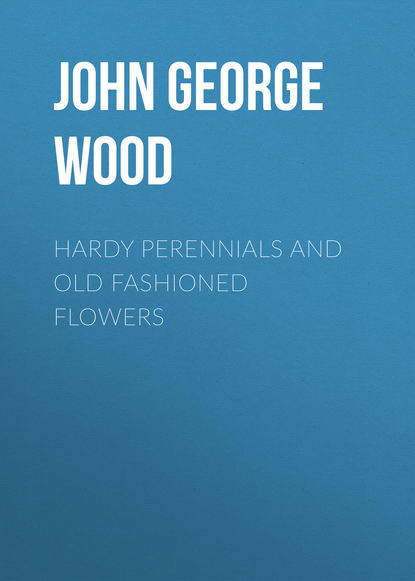 Полная версия
Полная версияHardy Perennials and Old Fashioned Flowers
It enjoys a sunny position, but I have it doing well in a northwest aspect; it may be used in bush form in almost any situation. Neither is it particular as to soil, but I should not think of planting a winter-blooming subject in stiff or retentive loam—that of a sandy nature is more likely to be productive of flowers. It is easily propagated from cuttings of the young wood; if they are taken in late summer, when the leaves are falling, they will root quickly. Before the strong west winds of autumn occur, it should be pruned, in order to prevent its being torn from the wall; if the prunings are laid in sandy loam, between shrubs, they will be sufficiently rooted for planting out by the following spring.
Flowering period, December to April.
Kalmia Latifolia
Broad-leaved Kalmia; Nat. Ord. Ericaceæ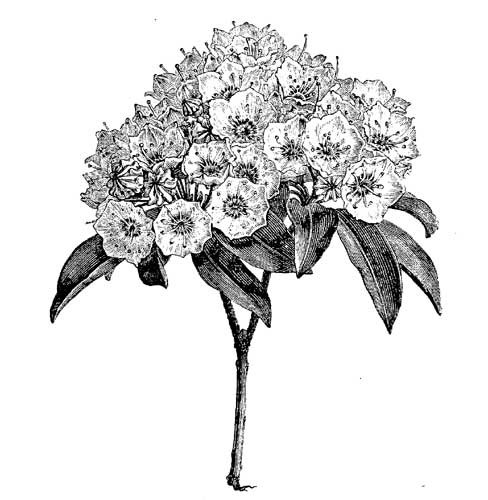
Fig. 56. Kalmia Latifolia.
(One-third natural size.)
An evergreen shrub, very hardy in our climate. It comes from North America, and from its dwarf character and free-blooming habit, it is not only one of the most useful shrubs, but may be freely planted in connection with herbaceous subjects, where it will help to redeem the deadness of beds and borders during winter (see Fig. 56). Like the rhododendron, it grows to various heights, according to the soil or situation in which it may be planted, but 18in. to 2ft. is the size at which it may often—perhaps most often—be seen producing its wealth of flowers. There are many fine flowering shrubs, but they do not gain the esteem in which this is held. Its large clusters of delicate flowers, surmounting dark shining foliage, and which seem almost too pure and beautiful to withstand the vicissitudes of the open garden, are its winning points; moreover, the flowers last several weeks in perfection. The flowers are arranged in broad panicles; the pedicels and five-cleft calyx are a bright brown colour, and furnished with short stiff hairs. The salver-shaped corolla, which is white, pleasingly tinted with red, has a short tube and five divisions, curiously cornered; the flower is fully ¾in. across, and in its unopened state is hardly less pretty than when blown. The leaves are borne on stout woody branches, have short stalks, and a bent or contorted habit; they are thick, leathery, shining, smooth, and of a dark green colour on the upper side; underneath they are a yellowish-green. In form they are elliptical and entire, being 3in. to 4in. long. Healthy specimens are well furnished with foliage; otherwise it is spare, and when that is the case the flowering is rarely satisfactory.
As this subject requires to be grown in moist vegetable soil, such as leaf mould or peat, it is useless to plant it where these conditions do not exist; moreover, the rule with species of the order Ericaceæ is to require a pure, or approximately pure, atmosphere. Doubtless these conditions will debar many from growing this shrub successfully; but I may add, where its requirements can be afforded, not only should it be freely planted, but it will probably thrive without any further care.
As a cut flower it is exquisite, if taken with a good stem and a few leaves; to many it may appear odd when I say it is too good to cut, but there are others who will comprehend me. The flowers can nowhere show to more advantage than on the bush, and it seems a pity to take its strongest branches for the sake of transferring the blossom.
It is a slow-growing subject, but easily propagated by layering the lower branches; no matter how old or hard the wood has grown, if pegged well down they will soon become rooted.
Flowering period, June to August.
Lactuca Sonchifolia
Sow Thistle-leafed Lettuce; Nat. Ord. CompositæThis is one of the few ornamental species of a somewhat numerous genus; it is, moreover, perennial and hardy in this climate—characteristics not common to the family. It came from Candia, in 1822, since which time it has been grown in English gardens, more or less, as a decorative plant; it is of unusual form, especially in the foliage. I think it would scarcely be called handsome; but the flowers, which are a fine pale blue, and of the form usual to the order, are too good to be overlooked, and their value is enhanced by the fact of their being produced so late in the year.
In speaking of the flower as a subject of the pleasure garden, it is unnecessary to describe it beyond saying that it is of a rich but pale blue colour, and over 1in. across, produced on stalks nearly 2ft. high, in lax panicles. The leaves are large—about 1ft. long and 9in. wide—have a stout midrib, are pinnate, and most curiously lobed. The leaflets, moreover, are fantastically shaped, being again lobed, also toothed and bent in various ways. The teeth have spine-like points, and the only uniform trait about their form seems to be that the edges are turned backwards. The upper surface is a pale green colour, the under side grey, almost white. It is of rather neat habit, and though I have not grown it in lines, it is only needful to see one good specimen in order to be certain of its effectiveness when so planted; it would be singularly distinct.
It enjoys sunny quarters and deep but light or sandy loam. With me it does well on a raised bed of light earth; its long tap roots will save it from drought during the driest summer, when its fleshy and fast-growing foliage would lead one to think that it could not endure a dry time. It is readily increased by division of the roots or seed.
Flowering period, September to strong frosts.
Lathyrus Grandiflorus
Large-flowered Everlasting Pea; Nat. Ord. LeguminosæA hardy, herbaceous climber, coming from the South of Europe. It was introduced to this country nearly seventy years ago; it is an attractive object when in bloom, growing 6ft. high and being very floriferous. The flowers are nearly 2in. across. Not only in good soil do specimens grow densely and become furnished from the ground to the extremities of the stalks with bloom, but the roots run under the surface so rapidly that a veritable thicket is formed in three or four years. It is as well to allow this fine pea a good broad space, in the midst of which several iron standards, 6ft. high, should be firmly fixed; to these, fresh twiggy branches might be secured every spring; if the old ones are left in, their rottenness will allow them to snap off during strong winds when the tendrils have laid hold of them; but fresh branches, used as suggested, will bend but not break, and will withstand the strongest winds. This is very important, as, if the mass of foliage heads over, it is spoilt for the season.
The flowers are dark rose colour, produced in twos and threes on longish stalks, which spring from the axils. The tendrils are three-cut, having a pair of oval leaflets; the stems are square, or four-angled, and slightly twisted and winged. This plant may be grown in any soil or situation. A specimen does well with me planted in rubble, where it covers a short rain-water pipe, the said pipe being feathered with twigs every spring; but to have flowers of extra size and luxuriant growth, plant in good loam, in a sunny site, and top dress with stable manure every spring. This large Pea-flower is most useful for cutting purposes, being not only handsome but very durable. The running roots may be transplanted in early spring, just before they make any stem.
Flowering period, June to August.
Lathyrus Latifolius
Large-leaved Lathyrus, or Everlasting Pea; Nat. Ord. LeguminosæThis deciduous climber is one of the handsomest plants of the British flora (see Fig. 57); in its wild state it is a charming object, and under cultivation, in full exposure to sunshine, with proper provision for its tendrils, and kept clear of weeds, it becomes in every way one of the finest objects in the garden, whether considered as a decorative climber, a floral specimen, or a source of cut flowers.
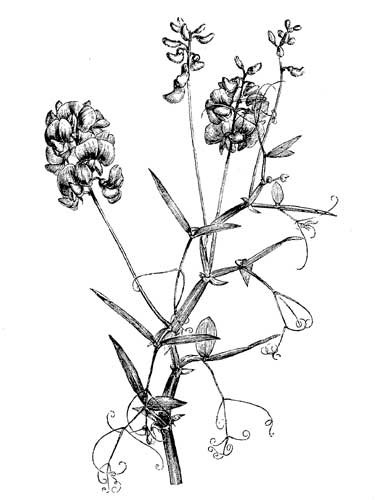
Fig. 57. Lathyrus Latifolius.
(One-sixth natural size.)
It grows fully 8ft. high, in deep and rich soil, and is furnished with large, many-flowered bunches of blossom from the leaf axils nearly all its length, each flower stalk being 6in. to 9in. long. The flowers are of a lively rose colour, about twelve in a cluster; tendrils five-cut, long, and two-leaved. The leaves are in pairs, elliptical, many ribbed, glaucous, and very large, whence the specific name; the internodes of the whole plant are winged, wings membranaceous; stipules large, broader than the stems. The habit is rampant; it enjoys sunshine, but will do in partial shade.
L. l. albus is a variety similar to the above in all its parts, but scarcely as large in the foliage, and the flowers are pure white, and produced a week or a fortnight later; for cutting purposes these are justly and highly esteemed.
Tall vases may be pleasingly dressed by the flowered stems, if cut about 3ft. long; these twined round or hanging down are very graceful, but they should not be used too freely—one, or two at most, on each large vase will be ample.
Both the above may be grown with good effect amongst other climbers, on a specially prepared trellis-work, ordinary pea-rods, or over defunct trees.
Propagated by seeds, or by division of very strong roots only. February is a good time for both methods.
Flowering period, June to August.
Leucojum Æstivum
Summer Snowflake; Nat. Ord. Amaryllidaceæ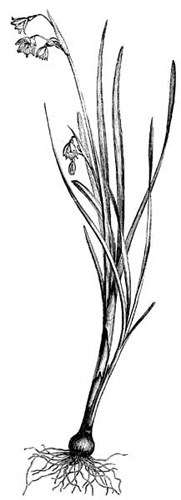
Fig. 58. Leucojum Æstivum.
(One-third natural size.)
As may be seen by the illustration (Fig. 58), this native bulbous plant is somewhat ungainly; blooming specimens are sometimes 2ft. high, and each one rarely produces more than three of its small flowers, but they are worth growing, because of their lasting properties, either cut or otherwise; the pretty snowdrop-shaped flowers are very effective when used in vases, their long stems rendering them more serviceable than they otherwise would be.
The white flower is without calyx, and has a corolla of six petals, each one being delicately tipped with pale green; they are produced on long thick stems, each flower having a somewhat lengthened pedicel, by which they are suspended bell-fashion. The foliage is of the common daffodil form, but longer; bulb small.
There are, it is said, two varieties of this species, which have generally become mixed; the other variety is said to be more dwarf and later in flowering; if this is correct, possibly these mixed varieties may have something to do with the long time which they are known to continue flowering.
Not only for the sake of preventing the tall growths from heading over should it be grown in broad masses, but when so planted this flower is more effective. It will grow in any kind of soil, but it seems most at home amongst dwarf shrubs, where its flowers are always of a more delicate colour than when exposed. Propagated by division of the roots during autumn every third year.
Flowering period, May to July.
Leucojum Vernum
Spring Snowflake; Nat. Ord. AmaryllidaceæA hardy bulbous species from Germany. It is not necessary either to describe or praise this beautiful flower, beyond stating that in every way it closely resembles the snowdrop; it is larger, however, whence the appropriateness of its name, Snowflake, in relation to that of the snowdrop. It will thrive anywhere but in wet, sour situations; it most enjoys fine light soil and the partial shade of trees, where it rapidly increases by offsets of the bulbs; these may, with advantage, be divided every three or four years.
Flowering period, March and April.
Lilium Auratum
Golden-rayed or Japanese Lily; Nat. Ord. LiliaceæThis is a hardy Lily, and though this particular species is comparatively new to our English gardens, it belongs to a noble genus which has had a place in our ancestors' gardens for ages. It was long thought that this bulb from Japan could not endure our winters, and though it is proved to be perfectly hardy, there are yet many who only cultivate it indoors, and seem surprised when they see it in beds and borders, where it is allowed to remain year after year.
The flowers vary very much in size, from 5in. to 8in. across; the divisions are richly tinted (golden-rayed), beautifully spotted and reflexed; the stems, at the height of 3ft. to 6ft., are furnished with flowers, mostly about five to eight in number. Though the flowers appear delicate, it is surprising how well they stand out in the open garden. For beauty and effect this Lily is incomparable (see Fig. 59).
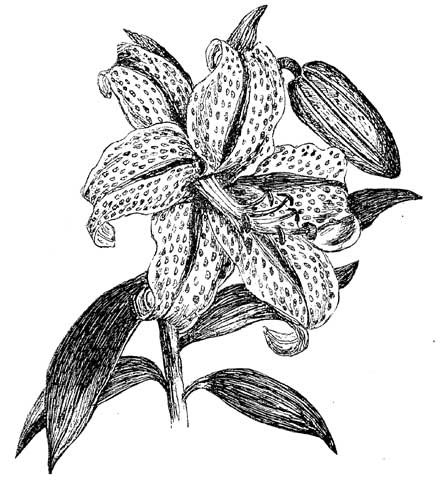
Fig. 59. Lilium Auratum.
(One-half natural size.)
Much has been said about its culture, far more than need be put into practice. I have found the observance of three simple rules sufficient in order to have it in fine bloom year after year: First, begin with good sound bulbs, not over large. Second, plant them 9in. deep in sandy soil, and a moist situation, surrounding each bulb with half-a-spadeful of fine charcoal, which protects them from rot, canker, and (what I believe to be the chief cause of failure) the wireworm. Third, grow them where they will be sheltered from high winds; otherwise their long and top-heavy stems become wrenched, and the upper roots, above the bulbs, so torn that the current season's bloom is more or less damaged and root development checked.
To put my simple method of growing this Lily in a plainer way, I may state that my garden is naturally well drained, has light soil, and a south aspect. Under a west wall I planted small bulbs in the manner already stated, and though I have often seen this Lily nearly twice as tall as ever I grew it, I have not any cause to complain about the quantity of bloom. I never either water or put down stakes as supports. If the situation is moist no water is needed, and it is next to impossible to send down stakes without coming in contact with the large bulbs. Doubtless a few good waterings with liquid manure would be an advantage, but where L. auratum is esteemed as satisfactory with short stems, this need not be given.
When once a clump or batch of this Lily has become established, it should not be disturbed for several years, when, if the stems are becoming too rank to allow them to wave without damaging each other's flowers, or if there are many young unflowered stems, they may profitably be dug out in a careful manner when the bulbs have ripened, which will be the case when the tops have become thoroughly dry; there will then be found to be numbers of nice clean young bulbs, which, with a year's extra patience, will probably form a more vigorous batch than the parent one. Such bulbs are properly called "home grown."
Flowering period, September to November.
Linum Flavum
Yellow Flax; Nat. Ord. LinaceæThis handsome shrub-like Flax comes from Austria, and is a comparatively new species in English gardens. It is not only a distinct form, but from the large quantities and more durable quality of its flowers, it proves itself a very useful subject for flower-beds and borders, where it should have the most select companions. It is classed as a hardy, herbaceous perennial; its woody character, and a few green leaves which it carries throughout the winter would, however, show that it is not strictly herbaceous. Its hardiness, too, will be questioned by many who have tried to winter it outside, more especially in the northern parts of Great Britain. It is only hardy under certain conditions, which, in effect, is saying that it is not perfectly hardy. It requires a light warm soil and a dry situation, besides which, if the winter is severe, it should be protected with a thick covering of ashes or cocoa fibre. This special treatment has been found needful in Yorkshire, but more south it has been proved hardy without such precautions. The neat habit and clusters of rich yellow flowers of this plant render it deserving of the little extra care above indicated; this, together with the fact that it is hardy in many parts, is a sufficient reason for naming it amongst hardy plants.
Its flowers are produced in branched heads, dense and numerous, on stems a foot or more high; each flower is 1in. or 1½in. across, the five petals being of a transparent golden yellow, distinctly veined with orange; they are broad, and overlap each other; calyx small, and of a dark olive-green colour; segments finely pointed. The leaves are 2in. or more in length, lanced, but inclining to spoon shape; sessile, stout, smooth, entire, and glaucous. Through the summer new stems are quickly grown, which, in their turn, become topped with clusters of bloom, and so a succession of flowers is kept up until autumn. On rockwork it is effective, the situation, to some extent, meeting the requirements of its somewhat tender constitution; it may also be grown well in beds or borders, but they should be of a sandy character, and raised, unless it is intended to take up the plants for the winter; in such positions four or five specimens form a charming group, and nothing can be finer than the effect of other Flaxes, of a tall and spray-like character, grown near and amongst this golden yellow, such, for instance, as L. Narbonnense and L. perenne.
It is easily propagated by seeds, which should be sown in the autumn as soon as ripe; it may also be divided, but I have found the quickest and best results from cuttings taken in a half-ripened state. They should be put round the side of a rather large pot in sandy peat; the warmth, shade, and moisture of a cucumber-frame will cause them to root quickly, when they should be potted off singly, so as to make sturdy plants before the winter sets in, and such young stock ought to be wintered in a cold frame.
Flowering period, August and September.
Lithospermum Prostratum
Prostrate Gromwell; Nat. Ord. BoraginaceæSometimes called the Gentian L., from its bright blue gentian-like flowers. By many this species is considered synonymous with L. fruticosum. They are, however, very dissimilar. Our subject is an evergreen and stunted trailer; L. fruticosum is a deciduous trailer and very vigorous; both, however, are perfectly hardy. The most striking characteristics of the Prostrate Gromwell are its fine dark blue flowers and procumbent habit. It is a native of France, and only within the last sixty years has it been introduced into this country. Its habit is most distinct as compared with the various long-stemmed species. It much resembles the well-known Veronica prostrata in its general appearance.
Its flowers are sparingly produced from the axils of the leaves, but, being large compared with the size of the foliage, they are very effective when they first open. The dark but bright blue corolla is tinged with red, but later on the colour becomes an unmixed blue, and the blooms increase in size until more than ½in. across. The complexion of the foliage is very dark (holly green), the leaves are about 1in. long, and are narrow and stalkless; they have much substance and are rather hard. The whole plant is thickly coated with hairs—a common feature of this order; but in this species the hairs are remarkably stiff, those of the edges of the leaves being almost thorny.
The form of growth assumed by this plant eminently fits it for rockwork. It should be so planted that its densely-branched stems can fall over the face of a light-coloured stone; in this respect it forms a good companion to the dwarf phloxes, but it is otherwise a superior rock plant, being more characteristic and prolonged in its flowering. It should be allowed to grow to a large size, which will require several years, or the object may be sooner gained by planting half-a-dozen specimens in a group; this should be done when the plants are young, as it is very impatient of being disturbed when once established. It would make a capital edging plant for small shrubs, to come next the grass, backed by a row of Erica carnea, which is also dwarf, a continued bloomer and contemporaneous. Its propagation can only be readily effected in this climate by cuttings, as it does not ripen seed well; it cannot be divided, because generally the little shrub has a short bole, therefore, cuttings must be struck from the previous year's growth; they should be dibbled into fine sand and peat, kept shaded and cool for several weeks; they root quicker during the warm season, when they are also less liable to be over-watered, which is a very common cause of failure in striking cuttings; they should be well rooted before the winter sets in.
Flowering period, May to July.
Lobelia Cardinalis
Cardinal Flower; Nat. Ord. LobeliaceæThis is one of the finest herbaceous perennials that bloom in October; stately, brilliant and lasting. There are many varieties of it, and of late years some extra fine sorts have been raised and named, all of which are good. The varieties differ much in the foliage as well as the flowers, some being much larger, and of a dark brown or reddish colour. The illustration (Fig. 60) is drawn from the typical form, which has smooth foliage; it is not so large as some of the varieties, but it seemed desirable to figure the type, otherwise the varieties might have proved misleading. To a more than ordinary extent this plant is called by its common name, "the Cardinal Flower," and I have very frequently found that it has not been recognised by its proper name, even by amateurs who had long grown it. "Is that tall plant a Lobelia?" has often been asked; therefore, common as the plant is, I thought it might prove useful to give an illustration. One of its valuable qualities is that it flowers for a very long time, beginning about the latter end of August and continuing until stopped by frosts. In the early part of October it is simply grand, as then not only the main stems, but the lower ones, are all furnished with their brilliant colouring.
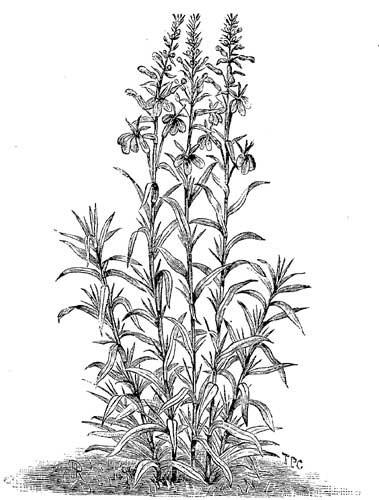
Fig. 60. Lobelia Cardinalis.
(One-twelfth natural size.)
This "old-fashioned" plant grows 2ft. or 3ft. high; the flowers are produced in terminal spikes on stout, round, and well-foliaged stems; each flower has a slender stalk, starting from the axil of a rudimentary leaf. The calyx is very finely formed, broadly cup-shaped and cornered; the five divisions are narrow, finely pointed, ¾in. long, and spreading; the corolla has a divided tube 1in. long, broadly set in the ample calyx, gradually narrowing to the divisions of the corolla. As may be seen by the engraving, the flowers much resemble some of our native orchids in form, the lip being most characteristic. The leaves are broadly lance-shaped, serrated, and sessile. The habit of the plant is erect, and almost rigid. The flowers are of the most attractive kind for borders, and, as cut bloom, can hardly be excelled.
The only drawback which attaches to it in this climate is that it is not perfectly hardy; in other words, it dies in winter when planted in certain soils and positions. But I can, from an experience extending over three trying winters, confidently state that, if it is planted in spring, in deep rich loam, fully exposed to the sun, it will both flower well and live through the winter. Only let the reader remember that it is a native of North America, and he may then judge that it can be no stranger to a cold climate. The advantages of the above method are, that the plant becomes well established during summer, its long cord-like roots get deep down to the moisture it loves so well, and from full exposure it withers seasonably and the crowns become fully ripened by the time the strongest frosts occur, so that they do it no harm. The reader may take it for what it is worth, that by leaving the dried stalks on, the plants are benefited; at any rate, I leave them on, for the following reasons: In a dry state they are very hollow, and when cut I have found them conductors of rain into the midst of the younger roots and dormant crowns, causing them to rot, and when the remaining part of the stalk has come away from rottenness too, it has been seen that a cavity of corruption had formed where it joined. When I have left the withered stalks untrimmed until the following growing season, no such decay has been seen. So that, after all, it is perhaps not less hardy than many other plants about which little doubt exists, but which may have been a little more fortunate as regards other conditions than cold.



